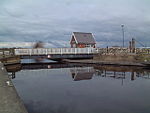Crowle Stone

The Crowle Stone is the remains of an Anglo-Saxon cross at the back of the Church of England parish church of St Oswald at Crowle, Lincolnshire.This was originally carved as a cross shaft and until 1919 it was used as a lintel over the west door. The preservation of the stone is almost certainly as a result of the Norman masons reusing it when the church was built in 1150.The stone measures 6 ft 11 in (2.11 m) in height 16 in (410 mm) thick and 8.5 in (220 mm) wide. The stone is ornately carved on all three sides. At the bottom of one face there is a runic inscription which would date the cross shaft as being before 950 as the use of runes had almost completely died out by then.
Excerpt from the Wikipedia article Crowle Stone (License: CC BY-SA 3.0, Authors, Images).Crowle Stone
Church Lane,
Geographical coordinates (GPS) Address Nearby Places Show on map
Geographical coordinates (GPS)
| Latitude | Longitude |
|---|---|
| N 53.6077 ° | E -0.8352 ° |
Address
Church Lane
DN17 4LQ , Crowle and Ealand
England, United Kingdom
Open on Google Maps








